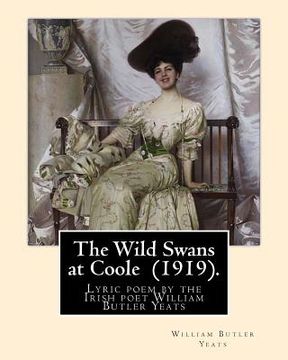The Wild Swans at Coole (1919). By: William Butler Yeats: "The Wild Swans at Coole" is a lyric poem by the Irish poet William Butler Yeats (1865-1939) (en Inglés)
Reseña del libro "The Wild Swans at Coole (1919). By: William Butler Yeats: "The Wild Swans at Coole" is a lyric poem by the Irish poet William Butler Yeats (1865-1939) (en Inglés)"
William Butler Yeats ( 13 June 1865 - 28 January 1939) was an Irish poet and one of the foremost figures of 20th century literature. A pillar of both the Irish and British literary establishments, he helped to found the Abbey Theatre, and in his later years served as an Irish Senator for two terms. Yeats was a driving force behind the Irish Literary Revival along with Lady Gregory, Edward Martyn and others. He was born in Sandymount, Ireland and educated there and in London. He spent childhood holidays in County Sligo and studied poetry from an early age when he became fascinated by Irish legends and the occult. These topics feature in the first phase of his work, which lasted roughly until the turn of the 20th century. His earliest volume of verse was published in 1889, and its slow-paced and lyrical poems display Yeats's debts to Edmund Spenser, Percy Bysshe Shelley, and the poets of the Pre-Raphaelite Brotherhood. From 1900, his poetry grew more physical and realistic. He largely renounced the transcendental beliefs of his youth, though he remained preoccupied with physical and spiritual masks, as well as with cyclical theories of life. In 1923, he was awarded the Nobel Prize in Literature. Early years Of Anglo-Irish descent, William Butler Yeats was born at Sandymount in County Dublin, Ireland.His father, John Butler Yeats (1839-1922), was a descendant of Jervis Yeats, a Williamite soldier, linen merchant, and well-known painter who died in 1712.Benjamin Yeats, Jervis's grandson and William's great-great-grandfather, had in 1773 married Mary Butler of a landed family in County Kildare. Following their marriage, they kept the name Butler in the family name. Mary was a descendant of the Butler of Ormond family from the Neigham (pronounced Nyam) Gowran branch of the family. They were descendants of the first Earls of Ormond. By his marriage, William's father John Yeats was studying law but abandoned his studies to study art at Heatherley's Art School in London. His mother, Susan Mary Pollexfen, came from a wealthy merchant family in Sligo, who owned a milling and shipping business. Soon after William's birth the family relocated to the Pollexfen home at Merville, Sligo to stay with her extended family, and the young poet came to think of the area as his childhood and spiritual home. Its landscape became, over time, both literally and symbolically, his "country of the heart" So also did its location on the sea; John Yeats stated that "by marriage with a Pollexfen, we have given a tongue to the sea cliffs". The Butler Yeats family were highly artistic; his brother Jack became an esteemed painter, while his sisters Elizabeth and Susan Mary-known to family and friends as Lollie and Lily-became involved in the Arts and Crafts movement. Yeats was raised a member of the Protestant Ascendancy, which was at the time undergoing a crisis of identity. While his family was broadly supportive of the changes Ireland was experiencing, the nationalist revival of the late 19th century directly disadvantaged his heritage, and informed his outlook for the remainder of his life. In 1997, his biographer R. F. Foster observed that Napoleon's dictum that to understand the man you have to know what was happening in the world when he was twenty "is manifestly true of W.B.Y."[11] Yeats's childhood and young adulthood were shadowed by the power-shift away from the minority Protestant Ascendancy. The 1880s saw the rise of Charles Stewart Parnell and the home rule movement; the 1890s saw the momentum of nationalism, while the Catholics became prominent around the turn of the century. These developments had a profound effect on his poetry, and his subsequent explorations of Irish identity had a significant influence on the creation of his country's biography...........

